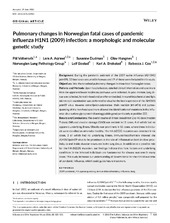| dc.contributor.author | Voltersvik, Pål | en_US |
| dc.contributor.author | Aqrawi, Lara Adnan | en_US |
| dc.contributor.author | Dudman, Susanne Gjeruldsen | en_US |
| dc.contributor.author | Hungnes, Olav | en_US |
| dc.contributor.author | Bostad, Leif | en_US |
| dc.contributor.author | Brokstad, Karl Albert | en_US |
| dc.contributor.author | Cox, Rebecca Jane | en_US |
| dc.date.accessioned | 2017-04-26T08:55:52Z | |
| dc.date.available | 2017-04-26T08:55:52Z | |
| dc.date.issued | 2016-11 | |
| dc.Published | Voltersvik P, Aqrawi LA, Dudman SMR, Hungnes O, Bostad L, Brokstad KA, Cox RJ. Pulmonary changes in Norwegian fatal cases of pandemic influenza H1N1 (2009) infection: a morphologic and molecular genetic study. Influenza and Other Respiratory Viruses. 2016;10(6):525-531 | eng |
| dc.identifier.uri | https://hdl.handle.net/1956/15711 | |
| dc.description.abstract | Background: During the pandemic outbreak of the 2009 swine influenza (A(H1N1) pdm09), 32 fatal cases occurred in Norway and 19 of these were included in this study. Objectives: We characterised pulmonary changes in these fatal Norwegian cases. Patients and Methods: Upon hospitalisation, detailed clinical information and specimens from the upper and lower respiratory pathways were collected. At post-mortem, lung tissue was collected, formalin-fixed and paraffin-embedded. Immunohistochemical and light microscopic examination was performed to visualise the local expression of the A(H1N1) pdm09 virus. Reverse transcription-polymerase chain reaction (RT-PCR) and pyrosequencing of the non-fixed specimens allowed the identification of mutations in the influenza virus surface glycoprotein (haemagglutinin gene) particularly at position 222. Results and Conclusions: The overall course of illness lasted from 2 to 40 days (median 9 days). Diffused alveolar damage (DAD) was evident in 11 cases, 4 of which had no apparent underlying illness. Obesity was prominent in 12 cases, where three individuals were classified as otherwise healthy. The HA D222G mutation was detected in six cases, 3 of which had no underlying illness. Immunohistochemistry showed the A(H1N1)pdm09 virus to be prominent at the site of inflammation both in close proximity to and inside alveolar structures in the lung tissue. In addition to a possible role for the HA D222G mutation, our findings indicate that host factors and underlying conditions in the infected individuals are fundamental for disease outcome in many cases. This study increases our understanding of determinants for the clinical outcome of pandemic influenza, which could guide future treatment. | en_US |
| dc.language.iso | eng | eng |
| dc.publisher | Wiley | eng |
| dc.relation.uri | http://onlinelibrary.wiley.com/doi/10.1111/irv.12410/epdf | |
| dc.rights | Attribution CC BY | eng |
| dc.rights.uri | http://creativecommons.org/licenses/by/4.0/ | eng |
| dc.subject | 2009 pandemic | eng |
| dc.subject | HA pyrosequencing | eng |
| dc.subject | immunohistochemistry | eng |
| dc.subject | influenza | eng |
| dc.subject | lung | eng |
| dc.title | Pulmonary changes in Norwegian fatal cases of pandemic influenza H1N1 (2009) infection: a morphologic and molecular genetic study | en_US |
| dc.type | Peer reviewed | |
| dc.type | Journal article | |
| dc.date.updated | 2017-02-16T12:03:19Z | |
| dc.description.version | publishedVersion | en_US |
| dc.rights.holder | Copyright 2016 The Author(s) | |
| dc.identifier.doi | https://doi.org/10.1111/irv.12410 | |
| dc.identifier.cristin | 1402967 | |
| dc.source.journal | Influenza and Other Respiratory Viruses | |

